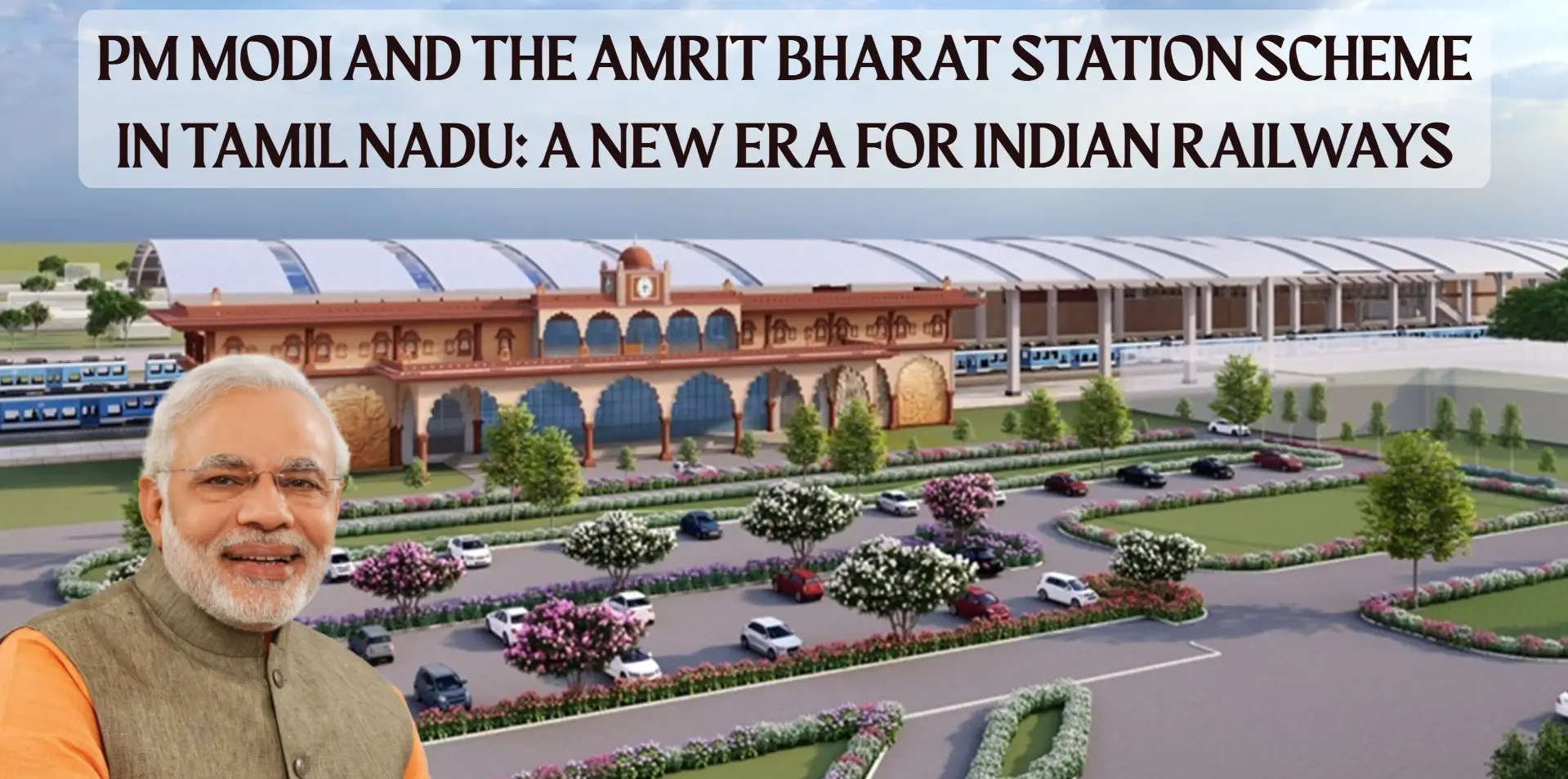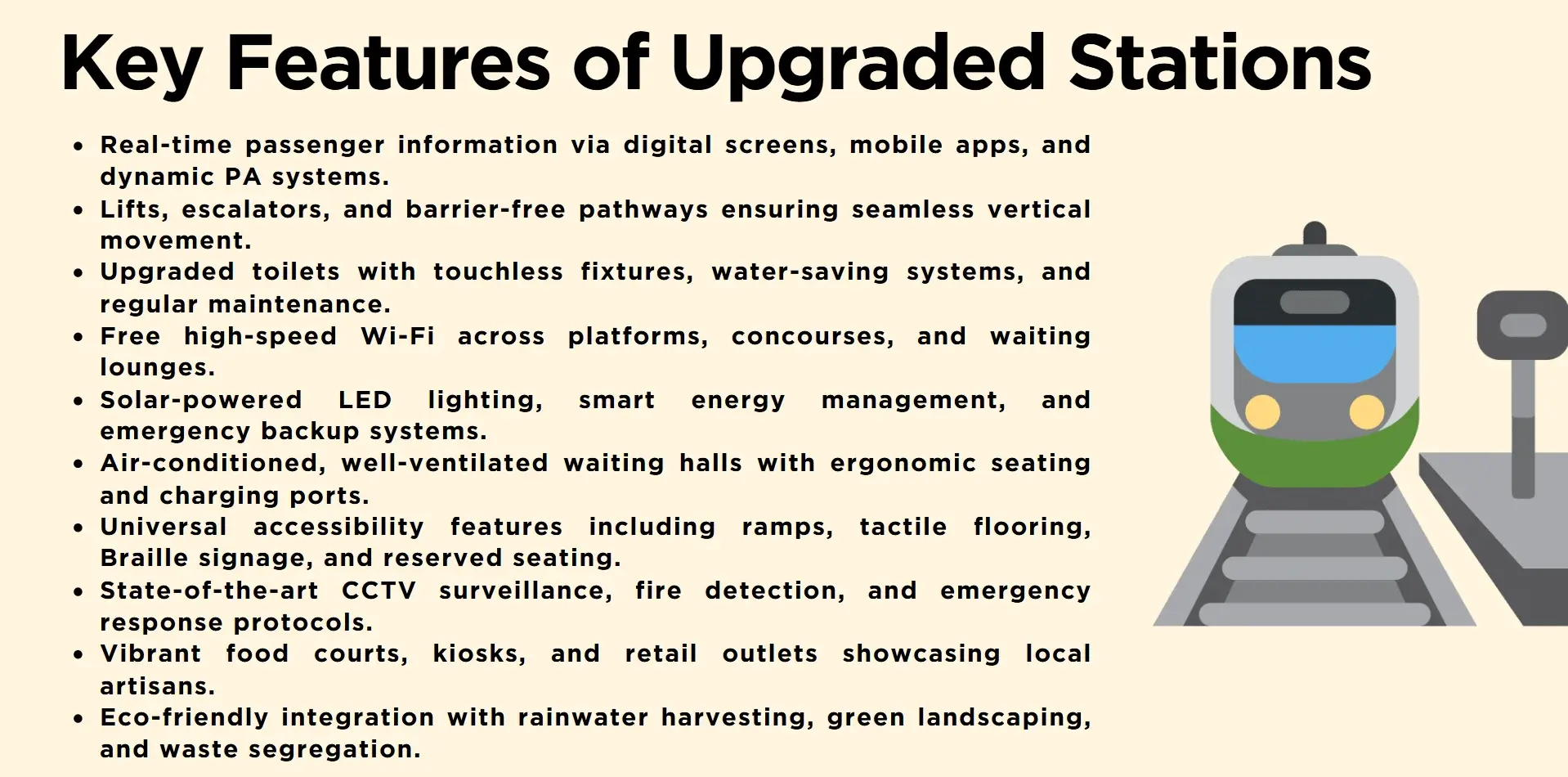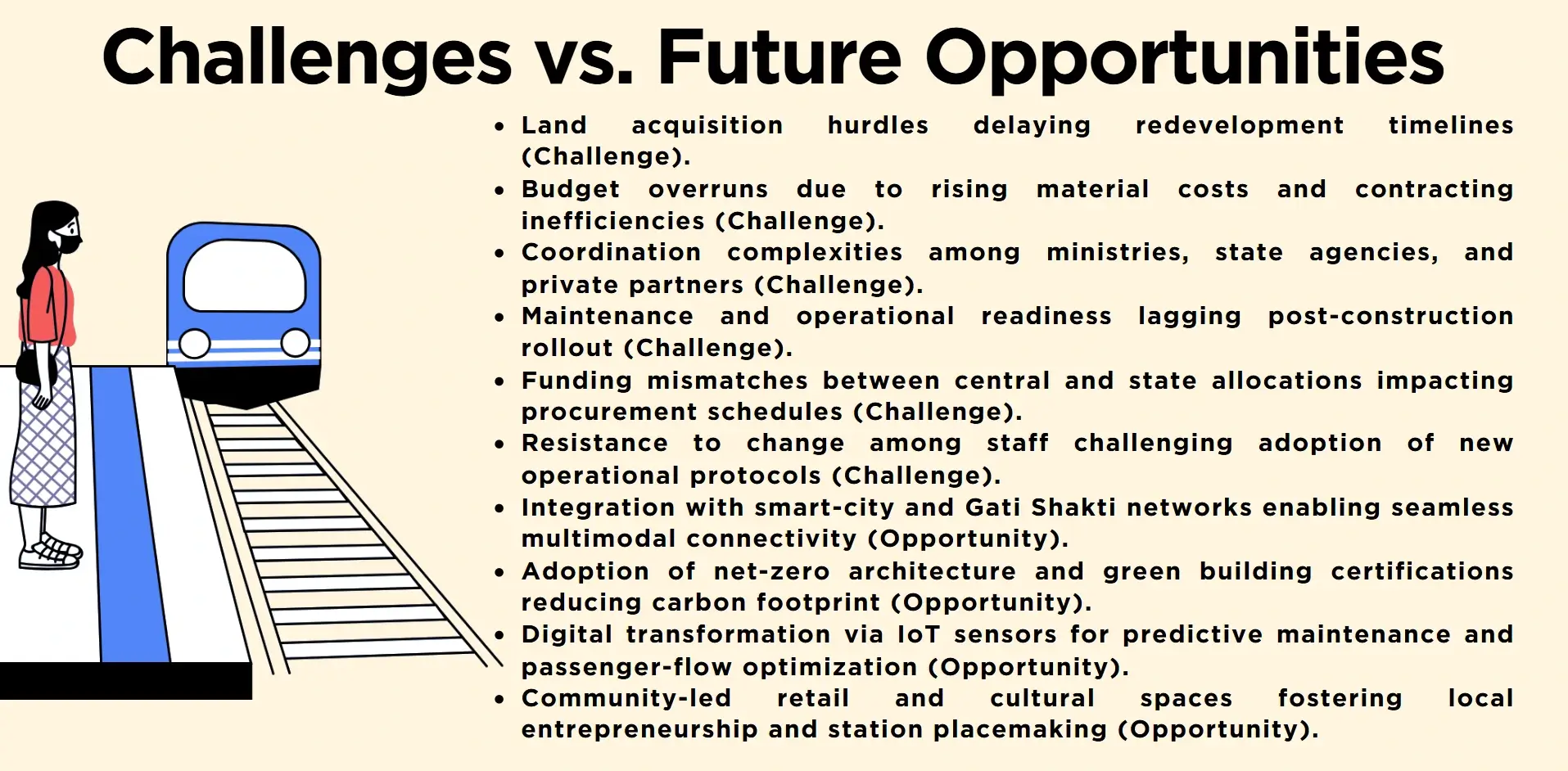The Amrit Bharat Station Scheme, a 2022 project to update Indian railway stations for improved connectivity, sustainability, and regional development, is the focus of PM Modi's visit to Tamil Nadu.

The project of modern and inclusive infrastructure in the country has gained new importance after PM Modi announced the ABSS as part of his visit to Tamil Nadu. ABSS is a long-term project of gradual modernisation of all the station facilities in the country, with more than 1,300 facilities being upgraded. The scheme seeks to redevelop transport facilities at the end of their life span into highly efficient, user-friendly zones with economic vitality by use of shorter-term schemes of redevelopment. There are 77 stations in Tamil Nadu alone, which fall under the purview of the revitalization initiative, which is deemed important in relation to better connectivity within a region, better commuter experience and unexploited local economic potential. The announcement by PM Modi also connects the plan to the larger Viksit Bharat, which has made ABSS part of the infrastructure revolution in India. By prioritizing sustainability, reliance on digital technology, and inclusiveness, the plan takes into consideration that the functioning of railway stations is changing dramatically nowadays, with a strong focus on the role of strategic development engines. The articlelooks into the genesis, characteristics, and the regional implications of ABSS, with a particular emphasis given to Tamil Nadu, and how many stand to gain with the upgrades, and the opportunities and challenges that there is to doing so.
History and Purposes of ABSS
Origin of the Plan
In response to poorly executed station development, the Ministry of Railways established the ABSS in 2022to implement fragmented reforms using decades' worth of accrued funds. Previous schemes, such as the Adarsh Station Scheme, lacked scope and investment and as such, much of the rail infrastructure in India falls short of contemporary demands. ABSS enhances these initiatives through its commitment to a long-term master plan approach by taking into consideration scalability, sustainability, and regional inclusion. In contrast to the previous plans, ABSS does not perceive the stations as simple nodes of transit but as a focal point of economic and social actions.
The Vision and Long-Term Goals
Deep down, the goals of ABSS include the ongoing and comprehensive development of stations, and not single-trip improvements by means of a changing plan of improvement. Rather than the use of just a few marquee stations, it encompasses urban, semi-urban, and rural nodes, and redevelopment based on local circumstances and the number of riders. The government also sees a smooth multimodal operability, where the campuses of its stations will be the future of smart cities, a stream of logistics, and corridors within the region.
User-centric design and inclusivity
The majorfocus is on the passenger experience. Under the scheme, there are requirements related to the upgrading of signage, displays, digital displayunits, waiting halls and executive lounges, lifts, escalators, and clean toilets. It focuses on accessibility of old age and people, real-time information systems, as well as convenience and safety. The Wi-Fi access, solar-powered lights, and green landscape are not options but the reality of the development spirit.
Sustainability and Local Economies in a joint effort
Continuous integration of stations into the local socio-economic life is also pursued by ABSS. Programmes such as “One Station One Product” are meant to boost local handicrafts, MSMEs and transform a station into a district hub of enterprise. Further, adherence to sustainable materials, energy-efficient building, and rainwater harvesting aligns with the scheme with Indian climate commitments. ABSS therefore serves as a convergence factor- where infrastructure, environment and uplifting of the community converge.
Characteristic aspects of the Scheme
ABSS envisages the Indian railwaysas smart, inclusive, and sustainably planned user spaces in the long term.
Transformation of Infrastructure
ABSS focuses on structural improvement that is much beyond the paint and polish. The new circulation spaces, better platform surfaces and the updated waiting halls make it easier to move people around. Elevators, ramps, and foot-over bridges bring about barrier-free access to the elderly citizens and the disabled users. Dignity in travel can be passed off as executive lounges, clean toilets andwell-ventilated restrooms. Additional security and information transparency are provided on digital display boards and interconnected surveillance systems with cameras (CCTV).
Digital and Smart Amenities
The plan integrates intelligent technologies into daily use of the station. The era of rail travel is also coming into the digital age through free Wi-Fi connectivity, real-time train status dashboards and e-ticketing kiosks. Technology aiming to create a better energy balance is in touchless entry gates, solar-powered luminations, and mobile charging stations, appealing to the tech-savvy passengers, as well. It is not just about being convenient as it involves the development of tech-integrated service ecosystems as stations.

Green Building Design
ABSS is designed to incorporate environmentally friendly design throughout. Materials used should be locally sourced, and there should be long-term landscaping and rainwater harvesting provisions to reduce the impact that the station has on the environment. Passive cooling is encouraged by bringing in natural lighting, enhanced ventilation, and limited carbon construction that will minimize the use of energy-intensive processes. Such characteristics position ABSS alongside the national climate action in India.
Local Enterprise and Economic Upliftment
The One Station One Product initiative turns stations into a new ray of development where local business can put forward their efforts to grow their businesses and contribute to the economy. Special places called kiosks are organized to advertise local artisans, agro-producers and microenterprises. Such a focus on creating values locally allows stations not only to become transit hubs, but also a sort of locomotive to drive the development and economic growth of the local communities.
Role of Tamil Nadu in the Scheme
Strategic Importance
The speech by PM Modi in Thoothukudi recently was an important reminder of the key synopsis of the ABSS rollout in the State. The state is the leader in the way the government has chosen to transform the infrastructure of India, with 77 railway stationsthat are to be redeveloped. This vast coverage is based on the dense rail system within Tamil Nadu, the presence of a high number of passengers, as well as the strategic position of Tamil Nadu linking trade routes in the south.
First-Phase Development
By mid-2025, nine stations in the state of Tamil Nadu had a completed Phase-I upgrade, some of these are Chidambaram, Srirangam, St. Thomas Mount, and Tiruvannamalai stations. These terminals now comprise shiny waiting areas, escalators, spotless toilets, and electronic facilities. Successful implementations of these pilot projects have provided the baseline experiencefor future stages and the administrative and technical readiness of the state.
Alignment with Wider Infrastructure Planning
Enrolment in ABSS is part of Tamil Nadu's wide development plans, which includeports, highways, airports, and energy corridors. The plan is a supplement to such existing programs as Outer Harbour Container Terminal and Thoothukudi International Container Terminal, establishing multimodal logistics hubs. Such synergy contributes to the connectivity of the region and makes Tamil Nadu a transit point to both India-specific and international trade.
Socioeconomic impact
It is hoped that the redevelopment of the stations will lead to local economies being kick-started due to easier access, tourism activities, and employment. Programs such as One Station One Product will exhibit the rich traditions of crafts that are present in the state of Tamil Nadu and promote the micro-enterprises. Technological improvements on the stations, with regard to aesthetic treatment and facilities, propel the journey into a higher level, too, making it an appealing means of transportation among the locals and the tourists.
Who Benefits?
The Amrit Bharat Station Scheme (ABSS) is an implementation service to provide a multidimensional advantage in social, economic, and environmental fronts, which would make the railway station a strategy of inclusive growth.
Passengers
The most fortunate are passengers who will get access to cleaner, safer, and more digitally enabled stations. This is complemented by features like escalators, lifts, executive lounges, and free Wi-Fi that enhance the comfort during travels, whereas a barrier-free design guarantees accessibility for elderly and differently-abled passengers. Improved signage and the use of real-time information systems help to minimize cases of confusion and to improve safety.
Local Communities
ABSS stations are institutions of local industry with programs such as the local crafts and micro-businesses through programs such as the One Station One Product. This generates revenue or other lines of income and enhanced cultural presence. Improved station aesthetics and accessibility encourage tourists to stroll through nearby towns and historical sites.
Regional Economies
Modernized stations promote a multimodal transport system that helps to transfer the flow of goods and people more easily. This is helping in the efficiency of supply chain, especially in the Tier-2 and Tier-3cities, and also helps in the industries of the regions by better able to access the market and ease of labor mobility.
Environment
Green buildings, designed with solar lighting and rainwater harvesting,make the station have a smaller ecological footprint. Its approach to integrating climate-conscious design can help the whole of India meet its sustainability objectives and provide a good example to future infrastructure initiatives.
Problems and Future Prospects
Having the scope and transformative intentions of the Amrit Bharat Station Scheme (ABSS), it nevertheless has a number of implementation obstacles that it is necessary to overcome to ensure that its maximum potentialis used within the Indian rail network.

Operational Bottlenecks
The main problem is to carry out upgrading work without any interference with day-to-day rail concerns. Delay in the building of foot overbridge, inadequate shelter coverage, insufficient facilities, even though the stations receive a large number of passengers, are a few cases reported by stations such as Tiruvallur in Tamil Nadu. Careful planning and prompt response are necessary to coordinate civil works while preserving commuter safety and service continuity.
Funding and Resources Allocation
The financial implication of the plan, which is 24,470 crore of rupees around the country,necessitates the redevelopment of over 1,300 stationsthat are still waiting to be redeveloped and therefore need a budgetary provision. It is important to provide an equal distribution between the cities of Tier-2 and Tier-3 since they may not occupy a large political presence as compared to metro regions. Clearance on how the funds were used or how or when the funds are to be disbursed is also crucial in ensuring that projects are not held up or regional inequities ensue.
Governance and Monitoring
The success of the scheme is dependent upon the central-state coordination and involvement of stakeholders in the area, where central-state coordination is completelyunrealistic. Poor timing in implementation, unfinished facilities (such as lifts, CCTV networks), and the absence of a system of accountability have presented themselves in a variety of places. By reinforcing monitoring systems and incorporating citizen input, there will be greater transparency and responsiveness.
Future outlook
Nonetheless, there is a possibility that ABSS will transform the situation in the transport sector in India. The future stages will combine stations and smart city facilities,digital tickets, and multimodal logistics terminals. The project is in line with the Gati Shakti Master Plan and Net-Zero Emissionsgoals,which place it at the centre of the sustainable future of Indian infrastructure.
Conclusion
The Amrit Bharat Station Scheme (ABSS) represents a paradigm shift in the vision of the Indian railway network, where they are upgrading infrastructure, combined with an inclusive, sustainable, and regional empowerment vision. In megacities as well as Tier-2 and 3 towns, the project is turning out grades into the gateways to growth, accessibility and cultural prominence. The active involvement of Tamil Nadu points towards the role played by the states in enhancing the priorities of the nation, with the ability tosmoothly integrate with larger transport and economic corridors. Modularity, long-term, of the scheme is promising to continue innovating and advancing the scheme, even though implementation problems still face the scheme. ABSS is not merely a facelift: a more strategic use of the public area by the people, the aim of the project is smart technologies, local enterprise promotion, and green architecture. The collaborative governance, financial commitment, and community participation will key to the success of the ABSS as India approaches the faster pace to Viksit Bharat. The railways that were once regarded as agents of movements are instead set to become centres of change.